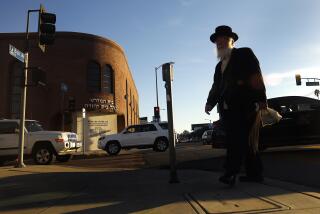Synagogue Protest Plays Out in Choreographed Struggle
- Share via
NEVE DEKALIM, Gaza Strip — Bathed in natural light streaming in through the windows, about 500 male protesters holed up in this settlement’s synagogue wrestled with Israeli police and soldiers for three hours, screaming insults and hurling bottles of water.
They thundered chants -- “A Jew does not expel a Jew!” -- and pleaded with the security forces to leave the synagogue alone. Dozens of men and boys sat in rows on the floor with their arms and legs knitted tightly. Some tore hats and radio equipment from the officers, who worked in teams of four to pry loose the protesters and carry them off.
Although the drama here Thursday looked like a chaotic free-for-all, the bedlam played out largely along ground rules set up by the two sides.
It was understood that the protesters would be allowed to struggle and hold fast, but not physically strike out at authorities. Police and soldiers took pains to avoid being too rough, although several appeared close to lashing out when youths grabbed them or hit them with full bottles.
At times, the showdown featured moments of surprising intimacy.
Troops could be seen in close conversation with activists, stroking their faces before picking them up to haul them away.
Police commanders and rabbis acting almost like referees closely watched how much force the officers employed to pull the activists away, and sometimes scolded when things got too rough.
There were short breaks to let each side catch its breath. Troops and activists offered one another drinking water in the steamy heat, and the officers frequently stopped to let the activists put back on their yarmulkes, knocked to the floor during the scuffling.
“We are the same nation. Brothers. My friends are here,” Brig. Gen. Gershon HaCohen said as the operation wound down.
Before the struggles ensued, the two sides had talked for hours, hoping in vain to reach an agreement under which protesters would leave the grounds of the synagogue.
The temple had been one of the last major pockets of resistance to the Gaza Strip withdrawal, attracting about 1,000 activists from the West Bank and Israel.
About 500 of the outsiders were women and girls who were removed from the women’s section of the synagogue. Unlike on the men’s side, though, few had to be carried off.
HaCohen declared the evacuation “well controlled.” As he spoke in the rear of the synagogue, the last wave of youthful settlers was noisily dislodged from the front, near the enclosure holding the Torah scrolls.
The general conceded that the day’s images, including tussling that spread to the platform from which the Torah is read during worship, would be hard for any of the participants to forget.
“Everyone will have these memories all his life,” he said.
At the end of the operation, after all the holdouts had been removed except for several rabbis and some settler leaders, the temple turned again to worship.
In a ceremony that appeared carefully scripted, soldiers and police, their uniforms stained dark from hours of physical exertion, joined in prayer led by Rabbi Yosef Elnekaveh.
Some wept loudly. The army and police commanders who led the operation were called to a raised area in the front to hold the scrolls.
But the moment of apparent reconciliation didn’t last long.
One police commander grew angry when, during the prayers, a settler leader castigated the officers who had carried out the eviction.
The commanders handed back the scrolls and stepped down to the floor, strewn with water and debris from the fracas.
More to Read
Sign up for Essential California
The most important California stories and recommendations in your inbox every morning.
You may occasionally receive promotional content from the Los Angeles Times.













